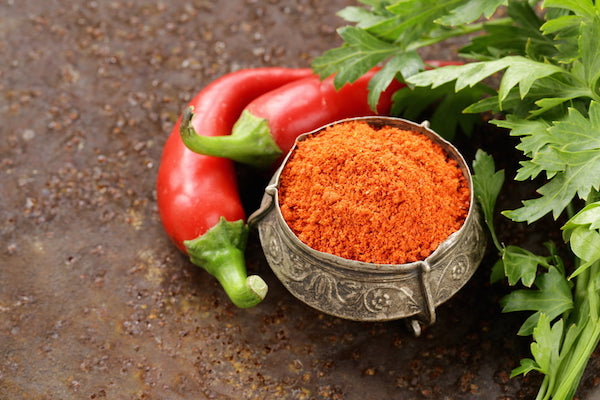May 14, 2015
Healthy Spices to Expand Your Palate
 Healthy spices are the perfect way to enhance your meals without sacrificing all the hard work you put into clean eating with your meal management. Who needs salt and sugars to season your dishes when you have all the many flavorful and healthy spices of the world at your disposal? Dive into our list for some aromatic inspiration below!
Healthy spices are the perfect way to enhance your meals without sacrificing all the hard work you put into clean eating with your meal management. Who needs salt and sugars to season your dishes when you have all the many flavorful and healthy spices of the world at your disposal? Dive into our list for some aromatic inspiration below!
Turmeric
What it does: Turmeric is well known for its singular yellow color, but did you also know that it can also provide pain relief? It has been investigated for possible benefits toward those suffering with Alzheimer's disease, arthritis, and cancer, among other things. Curcumin is behind many of turmeric's capabilities, as it has antioxidant, antibacterial, and anti-inflammatory properties. Last but not least, it can also soothe the digestive system. What to do with it: Curries, chutney, and sauces are the best bases for turmeric, but it can be added to meat and veggie dishes alike. The flavor is distinctive, and should be well-known to anyone who likes Indian dishes. It's often paired with cumin, coriander, and cardamom to balance the flavors. Take note: the dried spice has a powerful taste and is best a bit cooked.
Thyme
What it does: Thanks to its impressive antioxidant values, thyme is easily cast among the healthy spices. It also has anti-microbial properties, which helps your body stay clear of bacteria and harmful fungi. Thyme contains a multitude of needed nutrients as well, including vitamins C and A, copper, fiber, iron, and manganese. What to do with it: Thyme adds an earthiness to dishes that doesn't overpower other flavors. Among other things, thyme can be used to bolster meatloaf, soups, chowders, dry rubs, and sauces. Add some thyme to your pesto for a distinct flavor burst that's healthy, too.
Oregano
What it does: Oregano is well-known thanks to the popularity of pizza, but did you know that it has plenty of antiviral, antibacterial, antioxidant, and antibiotic properties? Healthy spices like oregano can't meet all your antioxidant needs, but they can help you attain a more broad ranger of nutrients when paired with veggie sides and the nutrients they provide. What to do with it: You surely know oregano from pizza and tomato-based sauces, but it goes very well with a wide variety of clean foods, especially Mediterranean dishes. Oregano and feta cheese, for example, are a perfect match for enhancing a dish. Enhance soups with oregano, as well. Italian oregano is the most well known, but different varieties offer different levels of bitterness, mintiness, and the surrounding flavors.
Cayenne Pepper
What it does: If you've ever looked into or attempted cleanses, you know that cayenne pepper is often a major ingredient. Not only does cayenne pepper have cleansing effects, but it also calms digestion and has a soothing effect on chronic pain. One study even showed that participants who included half a teaspoon of cayenne pepper in their meals burned more calories when working out. What to do with it: Among healthy spices, you know cayenne pepper is going to bring the heat. Use it anywhere you want to add a kick, but most commonly within sauces, casseroles, dips, and dressings. You can also use it like they do in cleanses by adding it to your morning smoothie, but remember not to go overboard. This taste is hard to cover up, but if you end up needing to dilute it somehow, try coconut milk or cream.
Ginger
What it does: Ginger is famous for its ability to soothe upset stomachs, gas, and bloating. It can also help many other conditions, including sore throats, colds, arthritis, and even motion sickness. The compound gingerol in particular is suspected to be the source behind these many health benefits, including decreasing inflammation and blocking nerve pathways that process pain. What to do with it: Savory yet sweet, ginger is one of those healthy spices that is known more for desserts than main dishes. If you enjoy Asian cuisine, you've more than likely enjoyed ginger in soups and stews. It's great in all its forms, but add it freshly grated to sautéed veggies and salad dressings for an immediate flavor punch and nutritional kick.
Cinnamon
What it does: The sweet lord of healthy spices, cinnamon also happens to boast one of the highest antioxidant values of any spice, too. Studies have shown that cinnamon can reduce inflammation, lower blood sugar levels, and ease nausea. It also contains manganese, iron, and calcium.Fun fact: Cinnamon actually kills bacteria. Next time you accidentally cut yourself in the kitchen, reach for the cinnamon!What to do with it: Much like ginger, cinnamon is well-known for its sweet uses, but it's also true that you can use it in plenty of the clean foods you fill your meal management system with. Breakfast is an easy time to incorporate cinnamon, such as sprinkling it on oatmeal, yogurt, or cottage cheese. At lunch or dinner, mix some cinnamon into your peanut butter for a slightly sweeter sandwich or sprinkle it atop veggies like carrots and sweet potatoes.
 Spices have no calories, need no prep time, and contain many healthy phytonutrients such as antioxidants. While no one is proclaiming that healthy spices are the cure to all the world's ills, we can't deny the compelling studies that show certain spices have health properties that can help fight against diseases.
Whether you use a gym tote, gym backpack, or sports duffle bag to keep your food safe while you travel fit, make sure to load up on the healthy spices above to keep your clean food tastier than ever. For more tips on meal management, check out our series on How to Meal Prep and for some nutritious recipes, check out our Meal Prep Sundays Recipes!
Spices have no calories, need no prep time, and contain many healthy phytonutrients such as antioxidants. While no one is proclaiming that healthy spices are the cure to all the world's ills, we can't deny the compelling studies that show certain spices have health properties that can help fight against diseases.
Whether you use a gym tote, gym backpack, or sports duffle bag to keep your food safe while you travel fit, make sure to load up on the healthy spices above to keep your clean food tastier than ever. For more tips on meal management, check out our series on How to Meal Prep and for some nutritious recipes, check out our Meal Prep Sundays Recipes!
